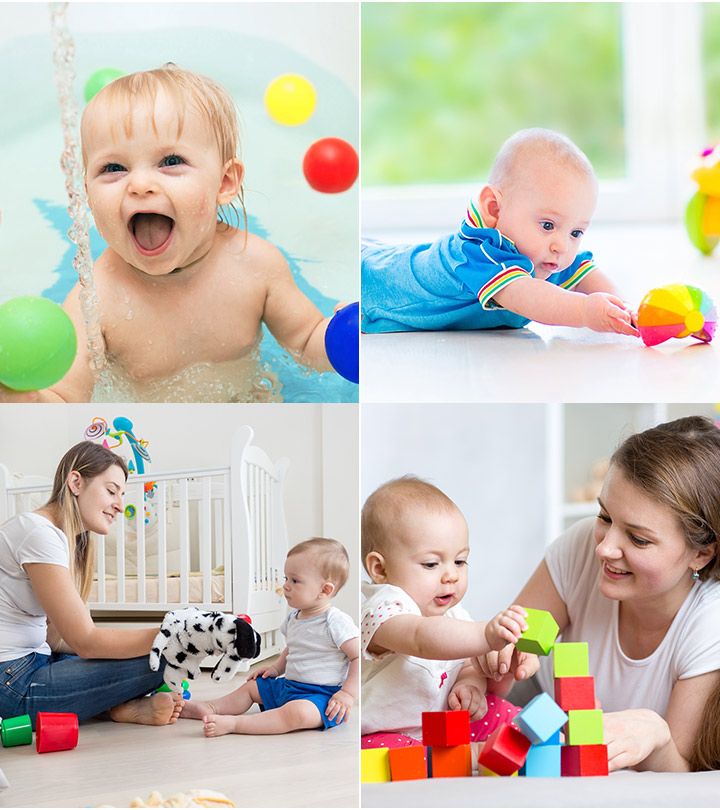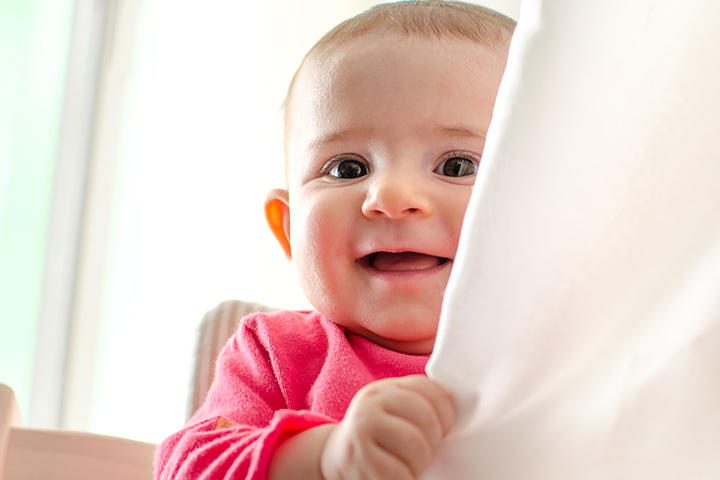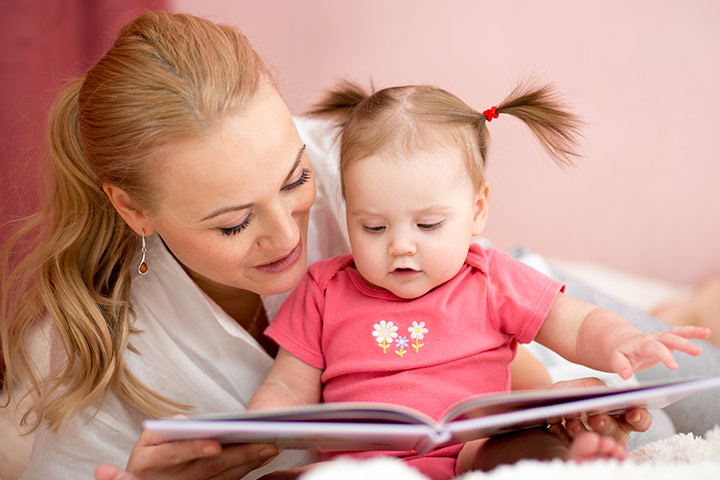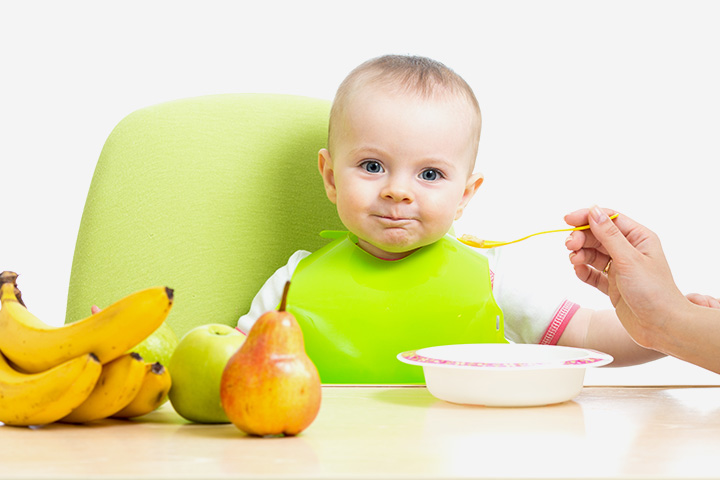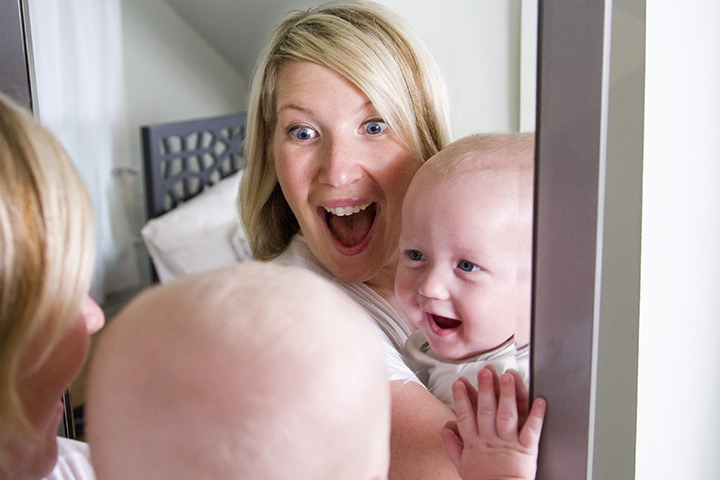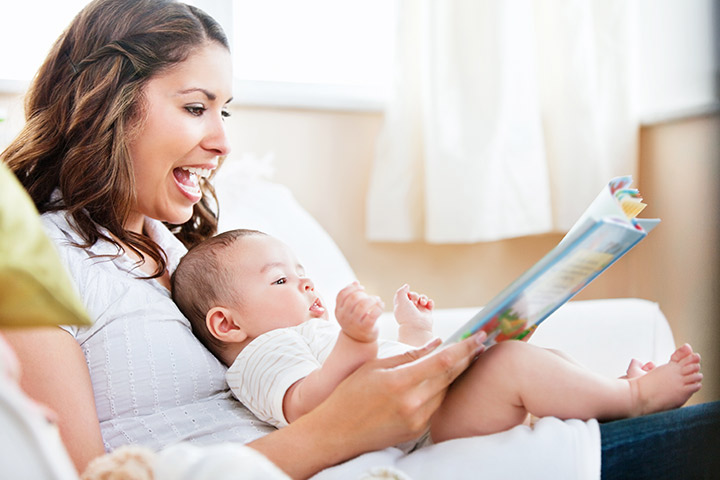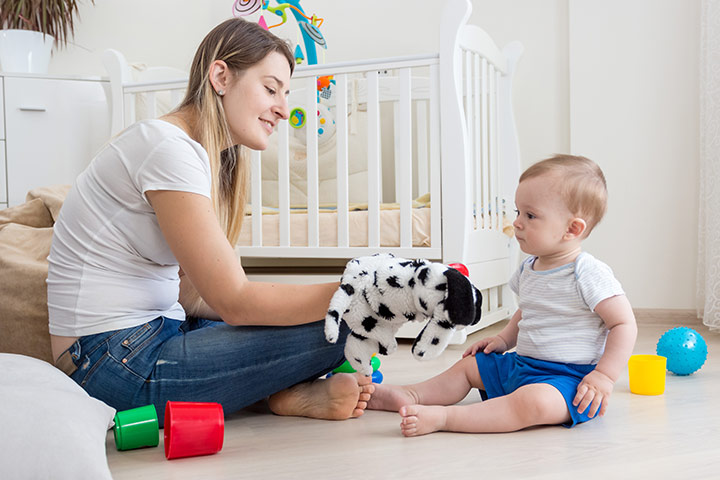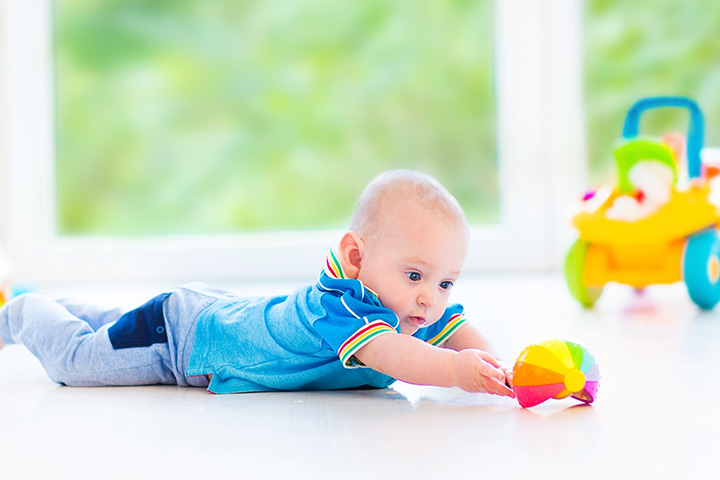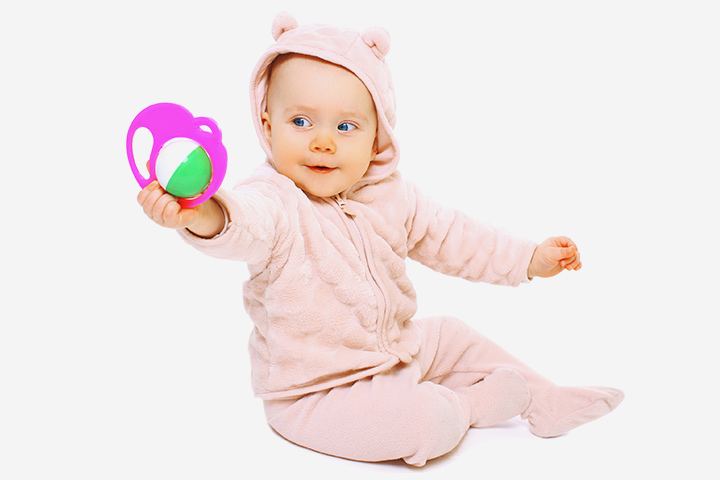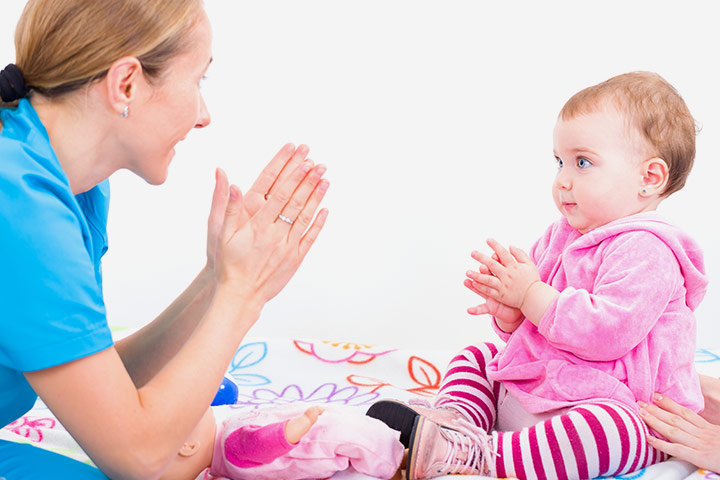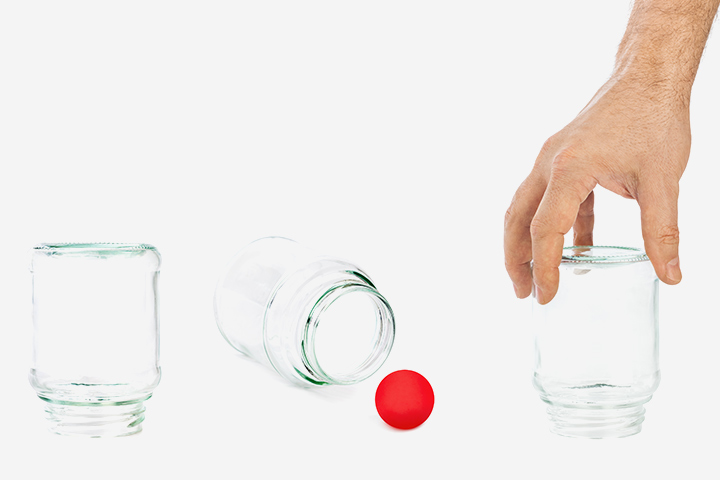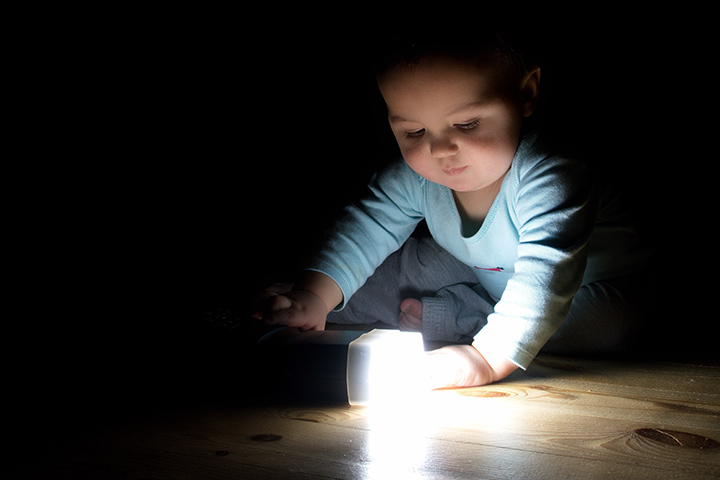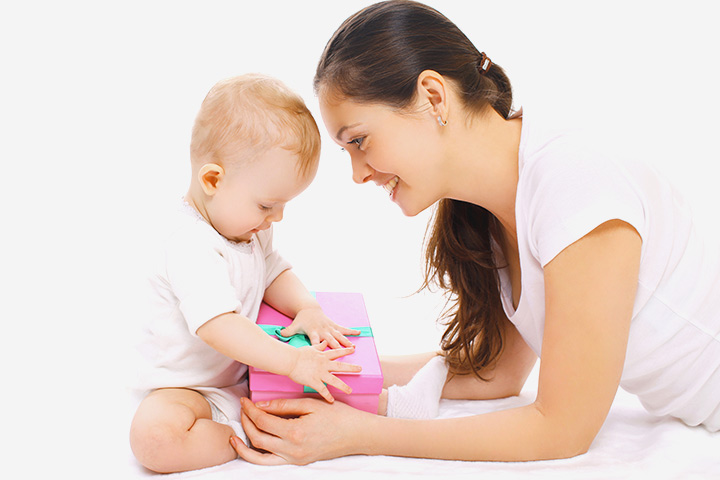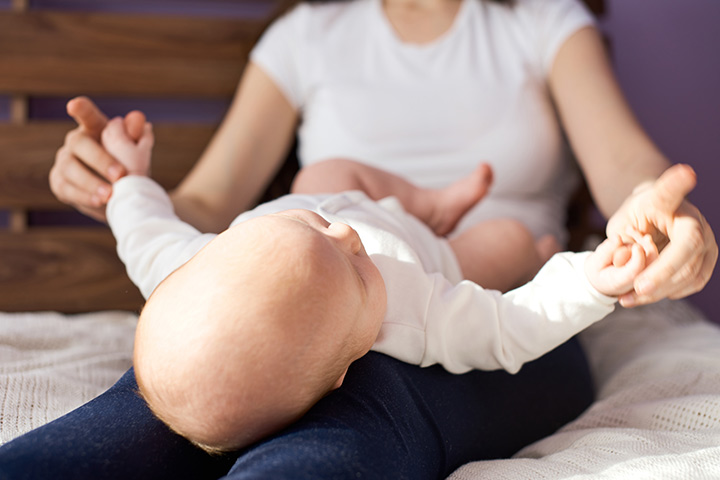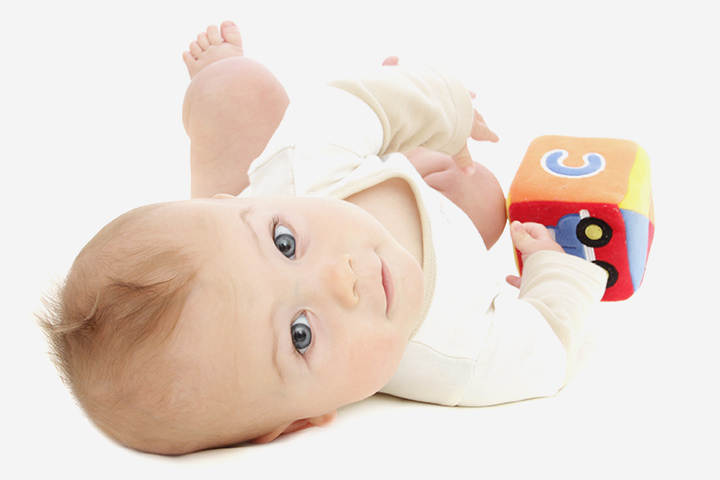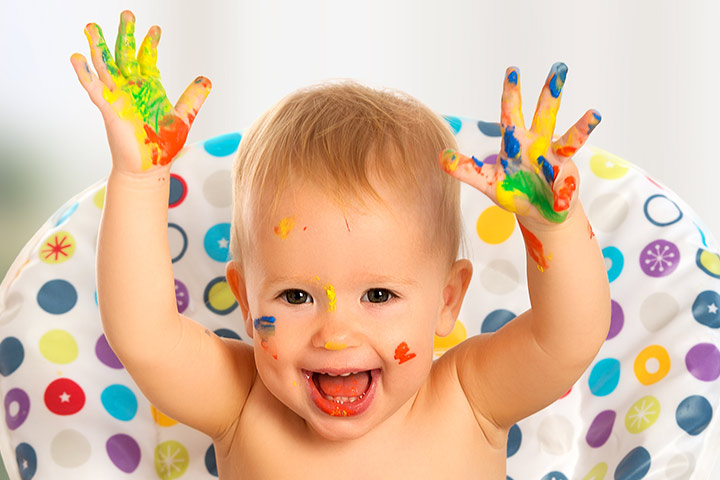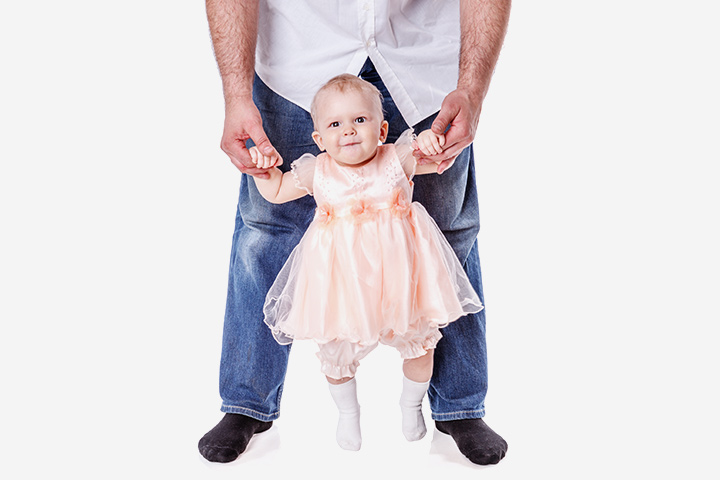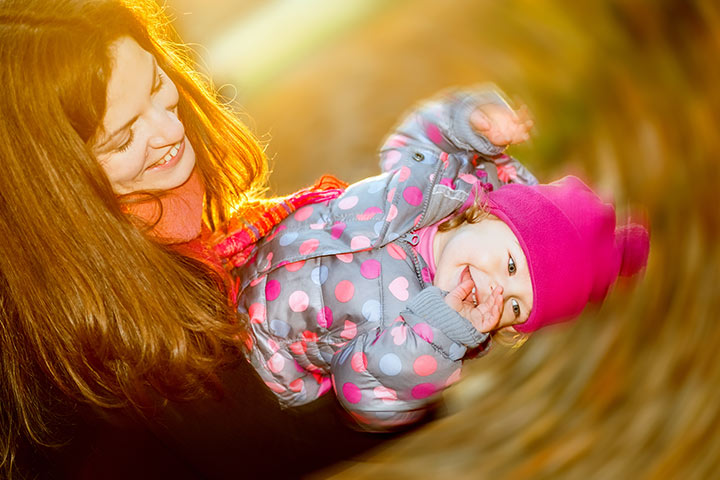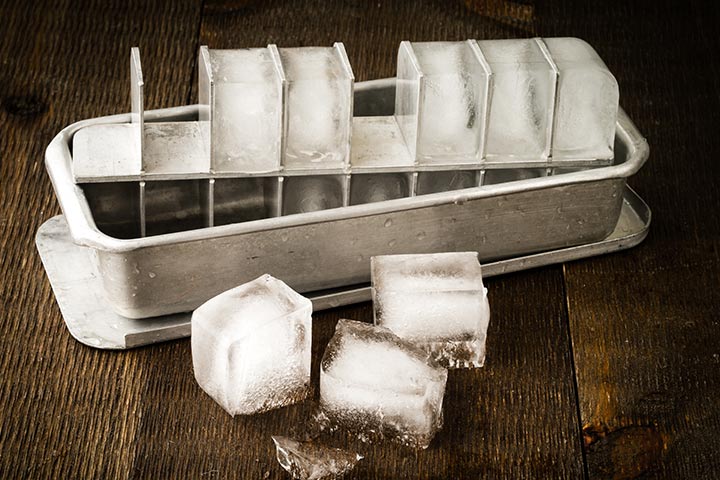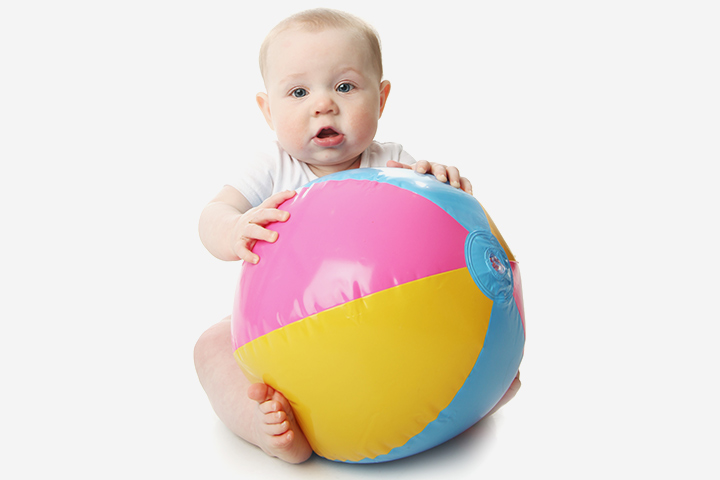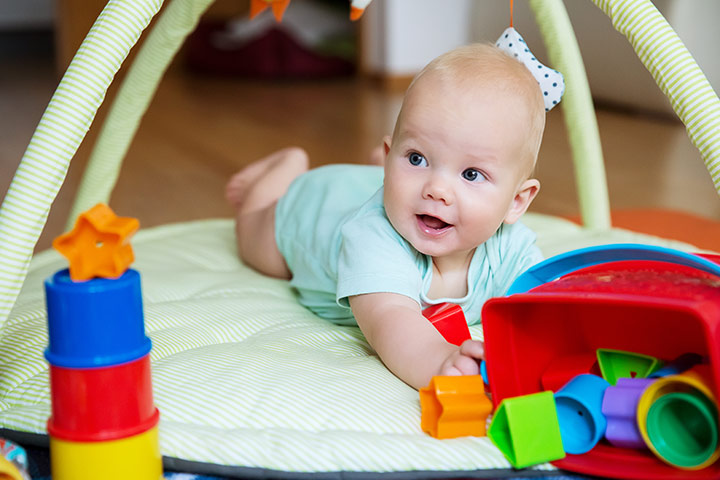At around seven months, your little one is sitting and likely to crawl to explore the world. The activities for a 7-month-old baby can help them master these milestones. They also boost the interaction with your little one while they start their pursuit towards skill progression. Seeing your little one grow up is guaranteed to bring you a lot of joy than ever before. Here are some games and activities you can help your baby with. Also, read through the benefits and tips to interact with your baby while getting them involved in these activities.
Key Developmental Milestones For A 7-month-Old
Knowing milestones helps in understanding if your baby’s development is on the right track. You can identify key growth factors and raise an alarm if the growth is halted.
- Eats pureed solid food: This is when he eats a lot of pureed solid food that his taste buds would have started enjoying. You still breastfeed him, but he now has wider options of nutrition than ever before due to his ability to eat other food. The food is simple and easily digestible. This is a milestone because it is an indicator of a developed digestive system.
However, it is possible that your baby may not immediately take a liking to solid foods when transitioning into the weaning stage. Addie Dwyer, mother of three girls, shares her new seven-month-old daughter Rosemary’s experience with solid food in one of her YouTube videos. She explains that even though her daughter started solids, she is not yet interested in it and not quite habitual to having things in her mouth. However, Rosemary does eat some of the food and also plays with it occasionally (i).
- Makes babbling sounds: He experiments with those vocal cords and tries making different sounds. Vowels are his favorite so expect a lot of ‘Aa’, ‘Ee’, and ‘Oo’ sounds. Making random sounds is another thing he loves while he experiments with the consonant sounds of ‘Mm’ and ‘Dd’. He may spontaneously make these sounds or respond to you. He may be at his loudest, and the pitch might really tear through the roof at times, but hey, isn’t that babbling adorable?!
- Experiences better locomotion locomotion skillsiXThe abilities that are crucial for a baby’s mobility and physical growth, including crawling, jumping, running.: Babies begin to crawl between the ages of seven and twelve months (1). This is a gradual process and does not happen overnight and begins with basic crawling on the tummy. Your little one may seem like he is dragging himself around but he is actually taking the first baby steps (quite literally!) to start crawling. Your baby may thus be a basic crawler and exploring when he is seven months old.
- Works on senses and body coordination: His senses are sharper. He looks up when his name is called or hears some sound, smiles when you smile at him, and picks up objects to pass them from one hand to another. Your seven-month-old also sits without support and happily reaches out to objects nearby by stretching his hands.
- Experiences social and emotional skill development: At seven months, infants reach important social and emotional milestones. You may find them responding to the people in the surroundings or shying away from some. They eagerly engage in social play and try to engage in interactive activities that foster connection. Fascinated by their reflection, they show an interest in mirror images, a sign of emerging self-awareness. Notably responsive, your little ones react to others’ expressions of emotion, often mirroring joy and forming the foundation for empathy (2).
So now we know the key developmental milestones of a seven-month old’s life, let us take a look at the various games and activities that can help bolster his development.
22 Games And Activities For 7-Month-Old Baby
These games and activities will help in your seven month-old’s physical, mental, and social development. We mention various skills nurtured through each activity and how it would be beneficial to your little one.
1. Who Is Calling Me?:
You will need:You, your partner, a curtain or different hiding objects
How to: By six months, babies learn to respond to their names (3). This means by the seventh month they get more discerning about being referred to by their name. ”Who is calling me” leverages this ability and uses it in the form of a game. You sit with your baby on the floor or the couch and ask your partner to hide behind a curtain at a distance and call your baby’s name. Observe your baby’s reaction and prompt him with words such as “Who said that?” and “Where is Daddy?”. Ask your partner to switch hiding spots and say your baby’s name. Your baby is going to turn around and look at different places to find the source of sound. Generally, this brings a smile to the face. It makes a great fun activity for the entire family for one lazy afternoon.
Skills developed:Auditory sense skillsiXThe capacity in babies to hear and comprehend sounds, including speech and music., curiosity, general muscle and listening coordination
2. The Family Picture Game:
You will need: A family photo album
How to: Your baby will have an ample sense of recognition of familiar faces. It is time to nurture it with this game. Make him sit on your lap and open a family photo album. Start showing him photographs of people he knows and interacts regularly with. Show bright colored pictures and closeups. Begin with your pictures (parents’) and slowly move to images of other individuals. Every time you show a photograph, point at the people in the picture and say their name or relation to the baby. Your baby may not understand everything, but he will get a sense that you are referring to the individual in the picture with that name.
This game, very easily, introduces your little one to new faces.
Skills developed: Basic understanding of facial features, visual perception
3. Blocks Play:
You will need:Colorful playing blocks for babies
How to:A set of playing blocks is a popular toy for babies and your little one is quite likely to have a set of his own. This is a simple Montessori activity for a seven-month-old baby where you can polish his motor skillsiXThe ability to control and coordinate body movements such as walking, running, and moving hands and fingers.. You start by making your baby sit next to you. Then, place the blocks at the front and start stacking them one on top of the other. Let the baby see what you are doing. Then make him hold one block in his hand and gently guide his hands to stack a block. Your baby slowly gets a sense of what is to be done and will start picking up the blocks himself and stacking them. Brightly colored blocks are to be used.
The baby’s block stacking ability is going to be shaky, and the stacked blocks will roll down soon but keep encouraging him to rebuild the stack. The baby may push the blocks down. The idea here is to acquaint him with the concept of stacking objects one atop the other.
Skills developed: Fine motor skills, object-location coordination
4. The Puree Game:
You will need: Different food purees that he normally eats
How to: Did you know that when babies are seven months old, they develop their very own preferences of taste (4)? Why not have an activity that is all about taste and eating? This activity exercises his sense of taste and also helps you observe his preferences. Make him sit next to you and place two different purees he usually eats. Let him have a taste of the first one. Once he swallows it, give him the second one. Observe his expressions every time he eats to notice which puree his face lights up to and which puree bowl he extends his hand to the most. Next time use two other different foods. The medley of tastes is going to keep him interested in the activity while as a parent you get an idea of which food puree he prefers.
Skills developed: Sense of taste and smell, general coordination of senses
5. Peek-a-boo With The Mirror:
You will need:Mirror, blanket or an object to hide, you and your partner
How to:Peek-a-boo is a game that never gets old no matter how old the kid may be. But in this game, we add a twist, and indulge in mirror play. Babies love looking at their reflections as early as the age of six months (3). They even look at the reflections of other people or objects in the mirror. This activity incorporates all these attributes to play peek-a-boo’s mirror version.
Sit with the baby in front of the mirror that is big enough for him to see the reflections of other objects. Ask your partner to hide behind an object or a blanket that is visible in the mirror and slowly peek out of it saying, “Peek-a-boo!”. Your baby is going to get curious and excited looking at this reflection in the mirror that is playing with him. Prompt him by pointing at the reflection of your partner in the mirror and saying “Look who is that?” or “See, there is Daddy!”. Be ready to be amused when he tries to grab that reflection.
Skills developed: Visual skills, basic understanding of depth and perception
6. Nursery Rhyme Time:
You will need:Brightly illustrated nursery rhyme book
How to:Rhymes are not just for older babies but also for the younger ones. Make your little one sit on your lap and open a brightly illustrated nursery rhyme book. Start reading the rhymes in a playful and musical manner while pointing at the illustrations. Your baby may not understand anything but he will be intrigued by the images and will be entertained to hear his parent speak in a playful manner. Try to use the rhymes in a sing song manner. He may try to mimic few words by babbling them. That is great as he is not just listening but also processing the words.
Skills developed: Listening skills, vocal representation of heard information
7. Hand puppet game:
You will need: Hand puppet and your partner
How to: Your partner can sit behind an object so that only the hand puppet is visible to the baby. He could also sit facing the baby. Either way, the focus should be on the hand puppet. Or you can do it yourself. Let your partner do some movements with the hand puppet while making some sounds such that it makes the baby think the puppet is really moving on its own. You can encourage the baby to reach out to the puppet and bring it closer to him.
Skills developed: Sound source interpretation, general auditory skills
8. Follow The Toy:
You will need:A stringed toy, your partner
How to:This is the age when babies experiment with their movements. Therefore, your baby could be crawling at seven months or at least making efforts to do so. This activity is a developmental game for the seven-month-old to encourage him to crawl.
Gently place the baby on his tummy, and then slowly bring a stringed toy in his field of vision. Once the toy has the baby’s attention your partner should slowly pull the string to move the toy. This way you would be prompting the baby to follow the toy. The toy having blinking lights or making sounds is an advantage as that will intrigue your baby to crawl or drag himself to follow it. This helps in overall cognitive and motor development. This is just the beginning, and a few months down the line you would be the one doing the chasing!
Skills developed:Muscle-sight coordinationiXThe capacity of the muscles to perform movements precisely and effectively in coordination with the eyes., overall physical dexterity
9. Grab The Rattle:
You will need:A simple rattle
How to: If the previous activity was to encourage your baby to crawl, then this one strengthens the muscles he needs for sitting. Babies can easily sit when they are seven months old. They even reach out for objects while sitting (5).
Make the baby sit in one place. You then bring a moving rattle to his attention and slowly bring it close to him. Place the rattle at a distance close enough for him to be able to lean and grab it. When he leans forward, gently pull the rattle away so that he grows determined to grab it. Let him get the rattle when he makes a second attempt at laying his hands on it. This activity improves vision, focus, and coordination.
Sitting and leaning forward helps maintain the posture and balance of the body, and this is only possible when the muscles of the back are quite strong.
Skills developed:Muscle strength for support, Muscle-sight coordination
10. Clap Together:
You will need: Yourself and your baby
How to: Make your baby sit opposite to you so that you have his attention. Then say a random rhyme or song and clap your hands to add a beat to it. Show the clapping action to the baby and observe if he replicates it by hitting his palms together. He will surely seem excited to do so. Let him clap by himself later. He might just pick it up perfectly, pretty soon. Babies enjoy clapping and this improves hand movements and coordination.
Skills developed: Cognitive abilities – ability to interpret and perform a viewed action
11. Hidden Toy:
You will need:Three transparent cups or bowls, a small toy
How to: This is a good ol’ cup trick modified to play with a baby. Take a set of three transparent (plastic or glass) cups and place them in a straight line, next to each other. You can also use large transparent bowls. Once you are set with the cups or bowls, take a toy that is small enough to be placed under the cup/bowl. Place this toy under one cup and let the baby see what you are doing. Slowly shuffle the cups while the baby is looking at you and observe the baby’s reaction. Once you are done shuffling, ask your baby to spot the cup with the toy under it. Tap the cup with the toy to give him some cue. Your baby will be quite engrossed by the sight of moving cups with a toy beneath it and may gently hit his hand on the cup that has the toy under it.
Skills developed: Object tracking, interpreting a moving object
12. Light And Shadows:
You will need:A flashlight, some objects, you and your partner
How to:This is perfect for nights when your baby seems in no mood to fall asleep. Sit with your baby while your partner turns on the flashlight and points it towards a blank wall. He then puts his hands in front of the light so that it creates different shapes out of the light. You can even place some other objects in front of the light such as toys, which can make interesting shadows. While these shadows form on the wall, you prompt your baby to look at them and use some funny cue words to attract his attention.
Your little one will definitely be fascinated by the light and shadow show from his front-row seat. The baby needs to be around nine months to be able to perceive this.
Skills developed: Sensory skills – interpreting light and shadow, exercising night vision
13. Noisy Container:
You will need:Two containers, baby cereal, and toy
How to: Now that he is seven months old, he will love hitting various objects to test basic cause and effect. Here is a way to hone his investigation skills through this fun-filled activity. Take a couple of containers and fill one of them with small toys, say building blocks, and fill the other with baby cereal. If you are outdoors, like on a beach, then you can fill the container with sand making this a great outdoor activity for the seven-month-old. Once the containers are full, bring them in front of the baby and rattle them in a way that the contents make noise. You can also hit them together to make some big noise. The baby will soon realize the source of the sound and will try holding the containers and move them on his own. Sounds are extremely important to get the baby’s attention. Immediate response to sound teats the babies hearing abilities.
Skills developed:Cognitive skills by understanding cause and effect
14. Baby Crunches:
You will need: You and your baby
How to:Time for a workout. Indulge in baby gym time by sitting on a bed with your legs outstretched and making your baby lie on your lap with his feet facing you. Once he settles in, gently hold his hands and pull him up a complete ninety degrees in a sitting position. Then slowly put him back to the lying down position. Sing a song or do something interesting to keep him interested while you repeat his crunches a few more times.
These crunches are great for the baby to exercise his neck muscles for the head while at the same time you can judge how developed his muscle control is. Neck holding and sitting are developed by this.
Skills developed:Muscle control skills and general dexterity
15. Roll Over To Reach It:
You will need: Rattle or a toy and your partner
How to:By seven months, babies can roll over to their tummy from their back. They can do this in either direction, which means they can roll over to their tummy from the left or right side. The objective of this activity is to nurture the muscles that help him do so. For this, you begin by placing your baby on his back. Then you bring his favorite toy, or any other object that will elicit a response from him, and place it on his left or right. Prompt the baby to roll and grab the object. Once he does, keep repeating the activity for alternative directions. This simple rolling activity keeps his muscle development up to mark.
Dwyer demonstrates a technique of elevated play to help Rosemary learn to crawl. In the video, she sits flat on the ground in a 90-degree position with her knees slightly elevated. Dwyer then holds a book or toy on the other side of the elevated knee so that her daughter has to get into a hand and knees position to reach for those objects over her legs. Her goal here is to get her daughter in a crawling position (i).
Skills developed: Muscular dexterity, vision-muscle coordination
16. Water toys fun:
You will need: A baby tub or plastic pool
How to: Engage in water play with a fun game for your 7-month old that you can play even during the bath time. Fill your baby’s bath tub or an inflatable plastic pool to half its capacity of water so that only the baby’s legs are covered. Place some water toys in the water and make your baby sit in the pool. Hold one of the toys and move them underwater in a manner that your baby observes it. Also, splash the water around using the toy to intrigue the baby while prompting him to grab it. Your baby will then reach out to a toy himself and try splashing them to test basic cause and effect as well as to get a sensory feel of the water. Be prepared for a lot of water splashing!
Skills developed:Sensory tactile feeling, cause and effect
17. Color Play:
You will need:Food purees of different colors
How to:Babies are fascinated by colors, and although you cannot expect him to paint anything while he is just seven months old, he will love dipping his hands in some bright colors. You can play this coloring game using some food-based purees of vivid colors. For example, you can use mango puree for yellow, beetroot puree for pink and other such food purees of different colors that you would normally feed him.
When the purees are all done, make your little one sit on your lap and put a plastic sheet in front of you with a large piece of white paper on it. The plastic sheet will help cleaning up easy later. Once you are all set, gently dip your little one’s hands in the puree and make a hand impression on the paper. Draw his attention using some exciting words and encourage him to do it himself. Your baby will soon dip his hands into the puree and smear them on the paper. Since the color is nothing but food puree there is no cause for concern if your baby puts his hands in his mouth. A wonderful and colorful game to play with your little one to stimulate his visual senses.
Skills developed:Visual sense – stimulation of color perception, general tactile skills
18. Bouncing On Feet:
You will need: Your baby’s favorite toy or a rattle, you and your partner
How to:A seven-month-old would still be far from taking his first steps but his legs are already attuned to the standing position. By seven months, babies will stretch their legs straight when held in a standing position and will bounce as if hopping at one place. These actions form the foundation for subsequent muscle development that facilitate the walking action.
In this physical development activity, we use this hopping motion to strengthen his leg muscles. Start by making your partner hold your baby in the standing position on a soft surface such as a bed mattress. Stand in front of your baby with his favorite toy or a rattle and hold it at a height that your baby can reach. Then ask your partner to replicate the hopping motion while holding the baby. Soon the baby begins hopping on his own and reaches out to the toy with every jump. Repeat the motion four to five times and then give a break for a few seconds before repeating it again. However, be careful to not put too much weight on the baby’s legs.
Skills developed: Muscle development, development of strength and dexterity
19. Dance and music:
You will need:Music and speakers
How to: Dance and music are amazing ways for the entire family to bond with the baby. The music you play can be soft and simple while the baby’s dance can be some adorable hand movements. Listening to music is beneficial to your baby since it improves the baby’s ability to process speech as well as his hearing and response (6). As for dance, it just adds the much-needed fun element to listening to music.
Play some soft music on low and comfortable volume. You can try different types of music and observe which one elicits the maximum response of excitement. Once the music is playing, make your baby sit in front of you and gently move his hands to the tune of the music. Add your very own sound effects to make things interesting. You will notice that your baby smiles and giggles every time you move his hands.
Skills developed: Cognitive ability by listening music, general social bonding skills
20. Sliding Ice Cubes:
You will need:Ice cubes, chopping board
How to: Sit with your baby with sensory toys like a bowl of ice cubes and a chopping board. Hold the chopping board at an inclination and slide an ice cube that eventually gets collected in the ice bowl. Repeat with multiple ice cubes and attract his attention by saying, “What is that moving?”. The sight of sliding ice cubes will fascinate him and he may try grabbing the ice while they slide. You can let him do so but make sure he does not hold it for too long since they are very cold or does not try swallowing it.
You can even hold your little one’s hand and make him slide an ice cube on his own to make the activity more fun. This activity helps in sensory development.
Skills developed:Sensory development – sense of touch and vision
21. Beach ball playtime:
You will need: Beach ball
How to:You can play this game at home or during an outing at the beach with the colorful beach ball. Start the activity by placing your baby in the sitting position or on his tummy. Then roll the ball around him in a manner that captures his attention. Once his attention is on the ball, slowly roll it towards him as if passing it on to him. Your baby will surely experiment by moving the ball around. His hand movements will be developed.
You can even place your baby on his tummy atop the beach ball while you hold him, which would help him flex his muscles eventually strengthening them. It is going to be a new fun experience for him. .
Skills developed:Core muscle strength, basic object tracking
22. Tummy Time:
You will need: Your baby’s toys
How to:Here is a developmental game that never gets old. Tummy time improves numerous growth parameters from physical to social and is a simple activity that can prove immensely beneficial to your seven-month-old. Simply place your baby on his tummy with his toys placed within his reach while some placed slightly beyond. Keeping the baby on the tummy helps in discharge of gasses, less colic and better neck holding. Your baby is now old enough to extend his hands, therefore, you can leverage that for his development. Involve yourself during tummy time play to keep your baby interested in the game.
Skills developed:Muscle strength, sensory skills, overall motor skills development
Those were some amazing games and activities to play with your seven-month-old baby for his physical, mental, and social development. Of course, as a parent, you must keep certain points in mind while raising him.
7 General Tips For Parents Of 7-Month-Olds
Playing a game with your baby can be a subjective experience for individual parents. Despite that, there are certain points that you must keep in mind while interacting with your baby through the use of games and activities.
- Let him take the initiative: As much as you would love to see your little one play, you must keep in mind that your baby must be the one taking the lead in a game/activity. If he seems to have a discernible disinterest in playing the game and appears irritable, then do not continue with the activity. Start another activity and if he does not seem to like it either then pause playing and resume it some other time. Remember, your baby is at the center of these games and activities therefore never force him to play anything.
- Be patient: Babies have personalities and can even have mood swings. Also, different babies have a different pace of learning. Therefore, do not fret if your baby seems to be showing a lag in his ability to understand the game/activity. He will learn it soon but worrying about it or forcing him to play the game can only make the matter worse. Patience is essential when playing with your little one.
- Have an activity schedule: If you want your baby to reap the maximum benefit of an activity then have a regular schedule of games and activities that you would like to conduct. Each game/activity targets a certain set of developmental milestones. Having a schedule will ensure that by the end of a week you have stimulated all these growth milestones for a holistic development of your baby.
- Take necessary precautions: Ensure you take the necessary precaution of baby-proofing your house to mitigate the chance of any injury. Cover all the pointy edges, store away sharp items, and keep all the cupboards locked. This will give you a peace of mind while he crawls unrestricted in the house to make his very own explorations. Also, use soft toys with out sharp edges and take precautions when the baby is playing and keep him safe from injury.
- Interaction is important: Do not be a silent spectator to your baby while he plays. Interact with him as much as you can since these are the moments when his senses are most attentive. Babies love playing with their parents, and your interaction will help nurture the necessary interest in the game.
- Give the baby ample rest: The best time to play is when he is awake and alert while seeming interested in the world around him. Play one game at a time and do not start an activity marathon. Give your baby some time to rest and absorb the things he learned in the activity. That way, you prevent fatigue while also ensuring that he does not get bored.
- Involve family and your partner: Social skills are as essential as other developmental milestones for a baby. Your little one should have ample interaction with both parents along with other members of the family. in addition to socializing with other babies. Games and activities are the best means to facilitate this interaction in an orderly yet fun manner.
The objective of these activities is to improve the development of the baby in different spheres of social interaction, cognitive development, and motor skills. However, remember to make these activities as part of the daily routine. Do not force the activities on the baby and give him time to get used to them.
Planning the activities for a 7-month-old baby around their key milestones could benefit their overall development. You can include activities that focus on developing their verbal and visual skills. Note their emotions associated with each game and engage them more in the type of activities they seem to enjoy. It may also help to maintain a fixed time for these activities and involve your family in the baby’s development. Each baby is different, so try various activities and give them time to grasp and enjoy an activity.
Key Pointers
- Games and activities for 7-month-old babies are designed to aid in their physical, mental, and social development.
- The aim is to enhance the baby’s development in various areas.
- Parents should allow the baby to initiate the games and avoid compelling them to play.
- Demonstrating patience is crucial, and scheduling activities can promote comprehensive development.
- The activities must be a regular part of the daily routine, and the baby should be provided with sufficient rest and time to assimilate what they have learned.
What are some fun and stimulating developmental games to play with your 7 month old? Discover a plethora of activities that will help your baby grow and develop.
